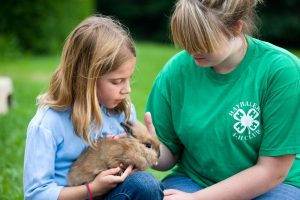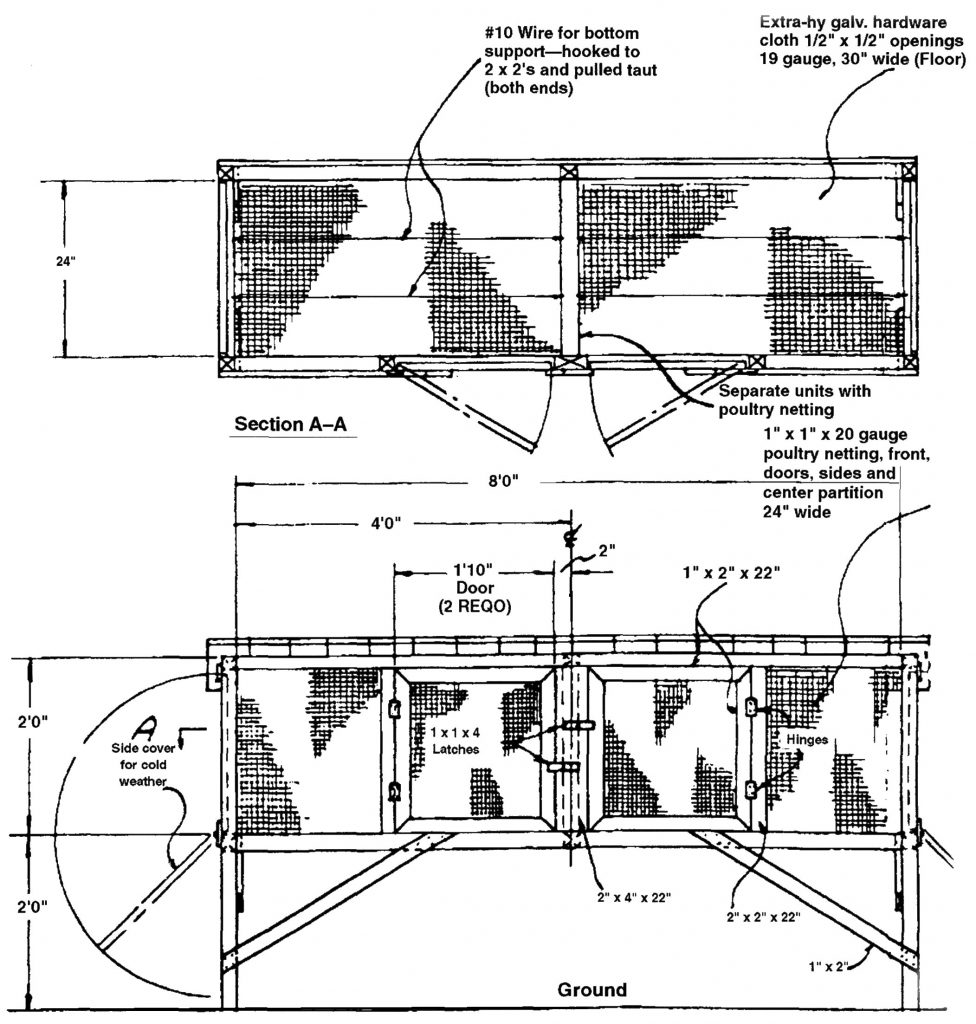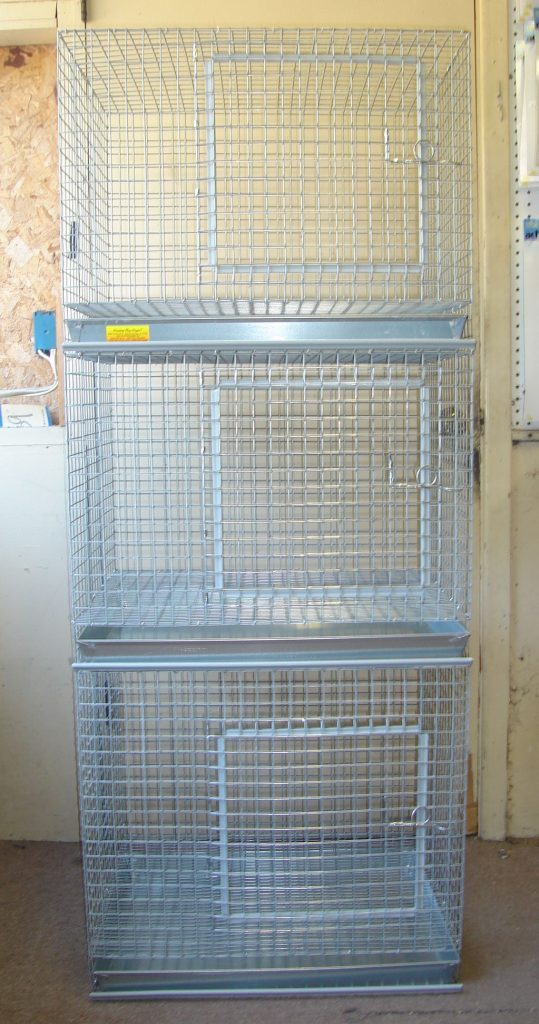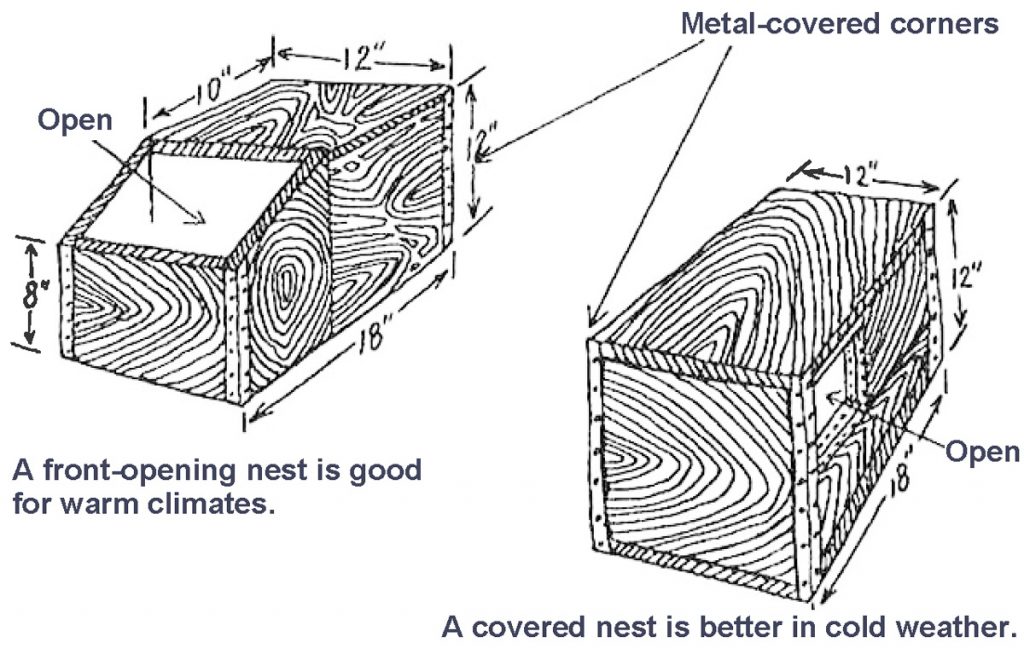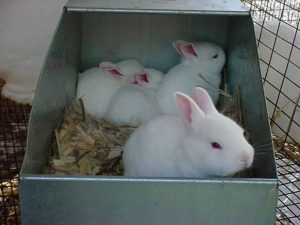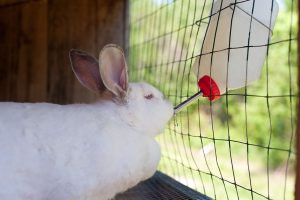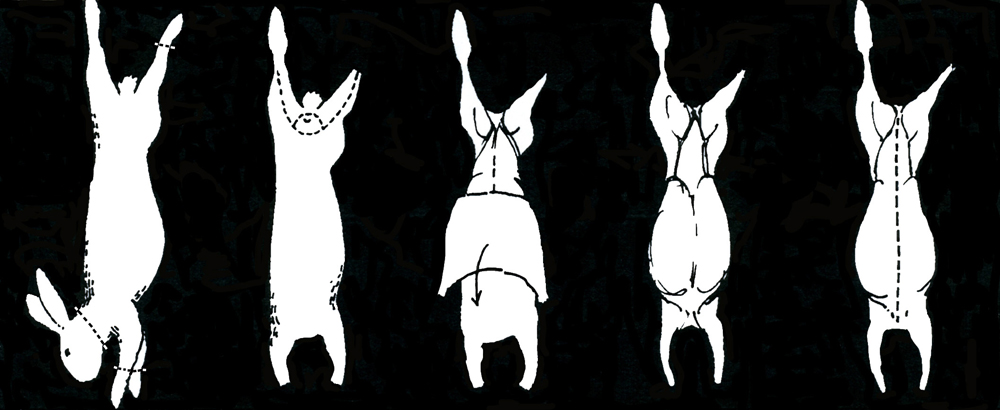Bulletin #1044, Backyard Production of Meat Rabbits in Maine
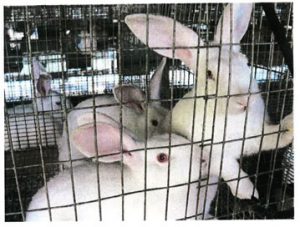
Adapted by Gary Anderson, Extension Animal and Bio-sciences Specialist, University of Maine Cooperative Extension
Reviewed by Extension Professor, State Livestock Specialist, Colt Knight, University of Maine Cooperative Extension
For information about UMaine Extension programs and resources, visit extension.umaine.edu.
Find more of our publications and books at extension.umaine.edu/publications/.
Table of Contents:
- Table 1. Nutritional Value of Rabbit and Other Common Meats
- Table 2. Composition (%) of Manure from Livestock
- Table 3: Projected Budget per Doe for Backyard Rabbit Farming (Jan. 2014)
- Maine Environment
- Breeds and Selection
- Reproduction
- Table 4. Management Schedule of 6 or 8 Litters Per Doe in One Year
- Table 5. Major Nutrient Requirements and Simple Feeding Chart
- Health Management
- Predator Control
- Market Outlets and Promotions
- Dressing Out a Rabbit Fryer
- Rabbit Recipes
The popularity of raising domestic meat rabbits as a small-scale backyard enterprise is growing in Maine. The benefits include nutritious food at a relatively low cost, the potential for extra income, and educational experience for the whole family.
The farming of domesticated meat rabbits is not a traditional agricultural activity in Maine compared with the production of beef cattle, goat, poultry, and swine. To date, there is little practical information available to assist rabbit producers. There are perhaps even more myths than facts about how to raise rabbits successfully.
The purpose of this publication is to provide general and practical information that will help the new producer become a successful producer of meat rabbits as a backyard activity under Maine conditions.
When planning your rabbit enterprise, identifying your goals and anticipated benefits is very important. For example, your primary goal might be to produce enough rabbits so that your family might consume meat from two fryers each week all year long. This production goal would require a small backyard operation consisting of about four breeding females (does) and one breeding male (buck).
Compared to most livestock or outdoor pets, rabbits are quiet, odorless, and docile animals that often go unnoticed by neighbors, even in residential areas. However, if you live within legal city limits, contact your town office to find out about possible restrictions concerning the keeping of rabbits. Overall benefits from a backyard rabbit enterprise include
- nutritious and wholesome meat,
- educational experiences for young people,
- an enjoyable occupational activity,
- rich manure for gardening or flower beds, and the potential for extra income.
According to the U.S. Department of Agriculture, domesticated rabbits produce an all-white meat product that is high in protein and low in fat and cholesterol (Table 1). For years, some physicians have recommended rabbit meat to patients with coronary conditions.
| Skinless Meat | Protein (%) |
Fat (%) |
Calories (per oz.) |
Cholesterol (mg per oz.) |
|---|---|---|---|---|
| Rabbit 1 | 22.8 | 6.3 | 44 | 55 |
| Beef 2 | 29.9 | 10.1 | 61 | 73 |
| Catfish 3 | 22.3 | 5.9 | 40 | 20 |
| Chicken 4 | 28.9 | 7.4 | 54 | 80 |
| Lamb 5 | 28.1 | 9.5 | 58 | 78 |
| Pork 6 | 27.7 | 14.8 | 60 | 72 |
| Turkey 4 | 28.9 | 4.9 | 48 | 65 |
| Source: USDA 1 Wisconsin Meat Facts and Analysis, Fact Sheet ME 87-3, USDA Handbook 8-17, 1989 (whole carcass) 2 USDA Handbook 8-13 Reo., 1989. (composite sample) 3 NutriFacts Seafood. (whole) 4 USDA Handbook 8-5, 1979. (composite sample) 5 USDA Handbook 8-10, 1991. (composite sample) 6 USDA Handbook 8-17, 1989. (composite sample) |
||||
For young people, raising rabbits, ideally as a 4-H or FFA club project, offers a wonderful learning experience in various aspects of the life sciences, including animal behavior, genetics, growth and development, and the anatomy and function of the reproductive and digestive systems. Particularly for a young child, rabbits are easy to handle and represent a minor investment. Raising rabbits also teaches responsibility, budgeting costs and returns, care and concern for animals, and the acceptance of livestock as a source of food for human beings.
As an occupation or hobby—whether for the young, the elderly, or any family member—raising rabbits can be an enjoyable and family-focused activity. The time or labor required to raise rabbits is about 20 hours per breeding doe per year. For the backyard operation with four breeding does, this labor input is equal to just 1½ workweeks (60 hours) per year, or less than 15 minutes per day. However, many families enjoy spending more time than this with their rabbits.
Rabbit farming complements the efforts of the serious gardener and flower grower. The manure from rabbits makes excellent compost, rich in organic matter and nutrients (Table 2). Commercial redworms or nightcrawlers grown in rabbit manure produce a superb and fairly odorless organic material. Many commercial rabbit producers sell both the organic material in bags and bait worms in cartons as a supplemental source of income. If your family enjoys fishing, you will also have a regular supply of bait worms.
| Animal | Nitrogen | Phosphorus | Potassium |
|---|---|---|---|
| Rabbit | 3.71 | 1.33 | 3.47 |
| Cattle | 2.90 | 0.72 | 2.14 |
| Poultry | 4.70 | 1.58 | 1.03 |
| Swine | 3.52 | 1.60 | 1.00 |
| Source: Various reports from the literature | |||
The small size of the backyard rabbit enterprise, typically four to five breeding does, represents steady meat production at minimal investment and operating costs. It takes little time or money to either scale down or expands the size of the operation. The labor required can be shared among almost all family members. These features mean that the rabbit enterprise carries minimum economic risk. This favorable “economy of scale” is highlighted in the budget shown in Table 3. The bottom line of the budget shows a net return per doe over annual costs, not including the cost of the buck or the building. This figure considers 30 fryers produced from one doe that are consumed or sold, based on an average market value per 4½-pound live fryer at 10 weeks of age. If the rabbitry is well managed, the family should be rewarded with wholesome and delicious meat at a reasonable cost. Each producer should evaluate the economics of rabbit raising on a regular basis looking at costs of production and net return.
| Life Span (years) | Purchase Cost ($) | Annual Cost ($) | |
|---|---|---|---|
| Start-up Costs* | |||
| Initial doe purchase | 1 year | 45.00 | |
| Cage (30 x 30 x 18 in.) | 5 years | 50.00 | 10.00 |
| Feeder (91/2 in.) | 5 years | 4.00 | .80 |
| Water bottle (32 oz.) | 5 years | 4.00 | .80 |
| Nest box | 5 years | 11.75 | 2.35 |
| Shipping | 24.00 | 4.80 | |
| Subtotal | 138.75 | 18.75 | |
| Annual Operating Costs** | |||
| Feed | 175.00 | ||
| Utilities (electricity, water, etc.) | 10.00 | ||
| Veterinary/Misc. supplies | 10.00 | ||
| Subtotal | 195.00 | ||
| Annual Returns*** | |||
| Value of 30 fryers (consumed or sold) | 262.50 | ||
| Return over investment | 123.75 | ||
| Return over annual costs | 67.50 | ||
| * Building and buck costs not included. Costs of these will change return over annual costs. Labor is assumed to be shared by the family and therefore does not represent an annual cost. **Feed reflects consumption by doe, 30 fryers from 6 litters, and one replacement doe fed to breeding age (5 months). ***Based on $1.75 per pound market value for 5-pound rabbit at 10 weeks of age. Make sure you evaluate your market before you start raising rabbits. |
|||
Maine Environment
With good commercial meat stock, adequate housing, and ventilation, and proper and timely management, the enterprise goal of year-round fryer production is certainly possible. One or more of these three basic necessities is usually lacking when poor fertility or production problems occur.
Commercial Meat Stock
Commercially bred rabbits are hardier and resistant to stress, in general, than purebred fancy rabbits. In commercial lines, the long term results from selection for production traits and crossing to introduce hybrid vigor provide the basis for the improved genetic quality. A commercial rabbit is capable of producing litters all year, and accordingly should not be allowed to remain idle for months without being reproductively active. On the other hand, purebred rabbits that lack this regular producing ability—or commercial rabbits that are managed to go on “summer vacations”—are more apt to become overweight and less fertile. An overweight rabbit will suffer the most during periods of high temperature and humidity. Later, when reproduction is resumed, discouraging results usually occur even for some months.
Housing and Ventilation
The rabbit’s immediate environment will have the greatest effect on production during adverse climates (whether heat waves or northern cold fronts). Complete wood-framed rabbit hutches should facilitate natural ventilation. If rabbits are raised in wire cages placed inside a shed, the width of the shed should not exceed 20 feet, and the structure should be ventilated (if this type of housing is used, there needs to be adequate protection from the cold during winter). If open sides are used during warmer weather, they should face the direction of prevailing breezes. During the summer months, especially, direct exposure of rabbits to sunlight should be prevented to minimize heatstroke. One practical alternative is to move the rabbits from a hot, poorly ventilated building to a location beneath large shade trees.
During the winter months, rabbits should be protected from direct exposure to cold drafts, strong winds, and chilling rains. For sheds, temporary plywood panels or roll plastic sheets may be used for this purpose. Rabbits housed in an unheated shed during cold winter months should have a protected area in the cage, such as a closed area with bedding so that they can seek shelter and stay warm. Some complete hutch designs provide for an enclosed wooden rear compartment for winter protection. In unusually cold periods, hutches or cages can be wrapped with inexpensive polyethylene sheets or old blankets if necessary.
Heat Stress Management
While we don’t see periods of extreme heat in Maine, proper management techniques should be followed to maintain normal fertility levels in commercial breeding stock during periods of high heat/humidity. The buck is more prone than the doe to experience infertility in the summer. Buck fertility may decline when temperatures are above 85°F for several consecutive days, but this is not often seen in Maine. Young bucks (6 to 9 months old) have higher fertility and sex drive than older bucks and can be mated to does during the summer season to achieve reproductive success.
Thermometers can be placed both inside and outside of the shed (or other building) as a check. A well-ventilated shed or even shade trees will help meet this objective.
Basic Housing and Equipment
If you do not already have a shed, there is little economic justification for the expense of building a new shed just for raising rabbits. A wiser investment would be to construct a complete rabbit hutch (Figure 1). You should locate the hutch in a safe area (for example, under shade trees or in a fenced lot), so that the rabbits will be protected from the natural elements, including predators. Wire cages (Figure 2) are designed for hanging inside sheds or other buildings. Cages are usually about 30 inches wide, 30 inches long, and 18 inches high for doe production or fryer growth purposes. For growing fryers, one cage for every two does is recommended. Ideally, fryers can be grown in used cages to offset costs. Bucks may be accommodated in cages with dimensions of 30 x 24 x 18 or 24 x 24 x 18 inches, depending on the size or breed of rabbit.
Commercially available feeder and automatic watering equipment can be used in the backyard rabbit operation. Water bottles or crocks are also popular. Nest boxes are discussed in the Reproduction section. For cages, feeders, waterers, and other equipment specifically designed for rabbits, one source of rabbit supplies are the Bass Equipment Company (P.O. Box 352, Monett, Missouri, 65708 or 1.800.798.0150). There are several companies that sell rabbit supplies; many poultry supply houses also sell rabbit materials.
Breeds and Selection
Breeding Stock
The American Rabbit Breeders Association recognizes more than fifty breeds of rabbit. However, most of these breeds are bred and raised strictly for fancy or show exhibition. In general, a fancy bred doe is unsuitable for year-round meat production. In other words, fancy rabbits are selectively bred for the show table rather than for the meat table. Examples of show table traits include body and head shape, fur type and coat, and toenail color.
Similarly, rabbits from pet stores and flea markets are not a good source of breeding stock. This is because such rabbits have an unknown background or are not from commercial meat-quality stocks. Instead, purchase your breeding stock from a reputable commercial breeder who provides pedigree and production trait information for each rabbit and offers the rabbits at a reasonable price. Make sure to check on the prices of commercial rabbits from several sources to make sure you are paying an appropriate price. There is no reason to pay more for a commercially bred rabbit, regardless of the age, breed or cross, or pedigree.
A commercially bred doe, purebred or crossbred, can produce 6 to 8 litters in a year. According to scientific studies, commercial bred stock, as compared to fancy bred stock, have more vigor and are more productive (for example, have higher fertility, kindle larger litters, and produce meatier fryers). For the backyard meat rabbit enterprise, purebred or fancy stock may not produce as well as the commercial rabbit, so you probably should not use them for meat purposes.
Breeding Systems
If you intend to use a single breed solely for backyard meat production, consider the commercial bred New Zealand White. Pure breeding or straight breeding is a simpler system than crossbreeding. However, because of hybrid vigor (a major advantage of crossbreeding), it is recommended that meat rabbit operations (large- or small-scale) use either commercial New Zealand White purebred or Californian X New Zealand White crossbred does. Both breed types of doe have outstanding fertility, mothering instinct, and milk production.
One breed weakness of the commercial New Zealand White is lower carcass dress out and a lower proportion of meat to bone. Fryer meat yield can be improved by using purebred Californian or Champagne d’Argent bucks for crossing with commercial New Zealand White purebred or crossbred does. Alternatively, faster gaining and more efficient terminal crossbred fryers that reach market size (4 pounds) at an early age can be produced by mating purebred Checkered Giant, Flemish Giant, or commercial ALTEX (developed at the Rabbit Research Center, Texas A&M University–Kingsville) bucks to New Zealand White purebred or crossbred does. The word “terminal” implies that all crossbred offspring are used for meat, with no offspring being saved as replacement bucks or does.
Replacement Stock Selection
The decision to select young replacement stock should be based on the production records of their parents. Trait averages from Buck Record Card (PDF) or Doe Record Form (PDF) can serve as a guide in making selection decisions. Important traits include litter size weaned, total litter weight at 21 days of age (an indication of milk production), and fryer weights at 8 weeks of age. Closely inspect each replacement candidate for heavy bodyweight, desirable meat type, and physical soundness, which includes lack of body defects or blemishes, normal teeth, and thick fur on the footpads. If you have a good-quality herd, it is less costly to produce your own replacement stock than to purchase new animals.
For More Information
The American Rabbit Breeders Association lists standards for 28 different breeds of rabbits. Contact them if you would like more information on a specific breed (P.O. Box 5667, Bloomington, Illinois 61702. 309.664.7500 or email: info@arba.net).
Reproduction
The most important key to successful backyard rabbit farming is reproduction. A good manager largely controls the level of reproduction with the goal of 6 to 8 litters produced per doe each year. You can improve your chances of a good level of reproduction through three primary management practices: proper breeding methods, care of the pregnant doe and newborn, and sound litter management.
Breeding Tips
A healthy and well-developed commercial doe can be bred at 5 months of age. In mating rabbits, the doe should always be taken to the buck’s cage, because the doe is territorial. Especially if a litter is present, the doe is more likely to defend her cage space than to show an interest in mating. Rabbits being bred should never be left unattended, for two primary reasons: the rabbits may fight and even seriously injure one another, and the manager will not know if a mating took place. It should take no more than 5 minutes for rabbits to mate. If a successful mating does occur (only one to two services are necessary), the buck snorts and falls to one side of the doe. The buck and doe ear tattoo identification numbers (or names) and the date of mating should then be transferred to record forms (buck record form (PDF) or doe record form (PDF)). A buck can service one or two does every other day, with a one-day rest period between matings. Only one buck is needed for every 30 does in a large operation.
Care of the Doe and Newborn
For rabbits, the pregnancy period (gestation length) is 30 to 31 days. The doe should be returned to the buck for service when her young are either 14 or 28 days of age (Table 4). However, if the doe appears to be in poor condition (underweight and rough fur) the mating should be delayed until body condition is restored.
When the doe is 28 days pregnant, provide her with a nest box for the new litter (Figures 3 and 4). Nest boxes are usually made of ½-inch plywood, with dimensions of 10 x 16 x 8 inches (width, length, height). A top piece for the nest box is unnecessary (except in cold weather). Fasten screen wire (⅛ inch) to the bottom of the nest box using wood molding and finishing nails. This feature promotes drainage so that the kits (newborn rabbits) remain dry, warm, and comfortable. The nest box should contain clean dry grass clippings, grass hay, wood shavings, or shredded newspaper to keep the newborn, furless kits warm. Since the doe may start to build a nest when the nest box is first provided, you may need to add more bedding material up to the time that the litter is born. However, some may show little interest in nest building until just minutes before the litter is born.
The delivery of newborn rabbits, which usually takes place in the early morning hours, is referred to as “kindling.” The typical size of the litter for commercial rabbits is seven to eight kits. Inspect the newborn litter promptly, so that you can determine the number of kits, remove the afterbirth and any dead kits, and manage the nest. Nest management consists of placing the live kits together into the nest constructed by the doe, then covering them with fur that the doe has pulled to provide warmth. It takes only a few seconds to inspect the litter every morning. A doe will not mind this brief but essential management practice. This inspection and handling of the kits will not cause the doe to abandon or lose interest in her litter.
A first-time doe is less likely than an experienced doe to make a good nest. You might need to help her line the nest with fur and deliver her litter to the nest. If the first litter is lost, always give the doe a second chance to successfully produce a litter. If the second litter is also lost, the doe should be dressed out or sold for meat.
Litter Management
Does nurse their kits only once a day — usually in the early morning hours — for about 3 to 4 minutes. Especially in a large litter, this gives the kits a brief period to feed and compete for sustenance for another 24 hours until the next nursing.
Good management practice is to equal out the number of kits per doe by transferring kits from one nest to another. The transfer of kits between does for nursing is called “cross-fostering.” For this useful practice to be successful, the does should be mated no more than 3 to 4 days apart. The main advantage of this practice is that competition for milk among kits is reduced in litters that would otherwise be very large. This results in higher kit survival and more uniform fryer weights by market age.
The litter can be weaned at 4 weeks of age since the doe’s milk production level is low by this time (Table 4). Weaning involves removing either the doe or the entire litter from the rearing cage. By 8 to 10 weeks (market age), most fryers should weigh at least 4 pounds. This is a good time to determine which fryers could be saved as herd replacement stock, as discussed in the Breeds and Selection section. Replacements should be placed individually in cages by 3 to 4 months of age, at least 1 month prior to first breeding.
| Litters per doe per year |
Age to wean litter | Time to rebreed doe * |
Litter interval ** |
|---|---|---|---|
| 6 | 28 days | 28 days | 59 days |
| 8 | 28 days | 14 days | 45 days |
| * Age of litter ** Number of days between litters if no infertile matings |
|||
Feeds and Feeding
Most rabbit producers use commercial feeds, such as pellets, in their operations. The advantages of feeding pellets include convenience to the producer and increased consumption with minimum waste by the rabbits. In addition, most manufactured pelleted feeds are complete formulations that do not require the producer to provide supplements, such as protein, vitamins, or salt. However, many feed companies have different rabbit feed formulations. A less-expensive diet is not always the best buy, because poorer production may possibly result. The best advice is to feed a reputable feed brand available at a reasonable and competitive price. If your rabbitry consists of at least 10 does, ask your feed dealer for a bulk discount on the feed purchase.
Discussion of each required dietary nutrient is beyond the scope of this publication. However, in terms of practical feeding, producing does, litters and young growing stock should be fed free-choice for best performance results. The mature stock that is not reproductively active should be limit-fed to maintain desirable body condition. As a general guide, a basic feeding chart is provided in Table 5. Rabbits should always have access to clean, cool water (Figure 5).
| Class of Production | Protein (%) | Fat (%) | Calories (per lb.) |
Fiber (%) | Daily Feeding Level |
|---|---|---|---|---|---|
| Pregnant or Lactating does (21 days or with litter) | 16–20 | 3–5.5 | 1136 | 12–14 | Free choice |
| Growing fryers (1–3 months) | 16 | 2–4 | 1136 | 14–16 | Free choice |
| Replacements (3–5 months) | 16 | 2–4 | 1136 | 14–16 | 6 to 8 oz. (0.25–0.3 lb.) |
| Breeding bucks (3 matings/week) | 16 | 2–3 | 1136 | 14–20 | 6 to 8 oz. (0.25–0.3 lb.) |
| Dry bucks/does | 12–15 | 2–3.5 | 955 | 14–20 | 4 to 6 oz. (0.25–0.4 lb.) |
| Source: National Research Council Publications 1194 | |||||
There is some local interest among producers to feed their rabbits less expensive hays, grains, lawn clippings, garden and kitchen wastes, etc. This practice usually results in a poorer overall diet quality, which in turn results in lower reproduction and growth response. You should be aware that it is the quality of the diet rather than the quantity that determines performance results. However, as long as the nutritional needs of the rabbit are satisfied, it doesn’t really matter which feed ingredients are actually fed. Simply feeding a good commercial pelleted diet takes out much of this guesswork. On the other hand, there is no problem in providing small amounts of fresh feeds (for example, a carrot, a few blades of grass, or a couple of cabbage leaves). This practice will help to stimulate appetite and promote gentle behavior in rabbits. The fiber content of the diet (15 percent) is important in preventing hairballs, stimulating gut function, and preventing diarrhea.
Health Management
Properly fed, housed, and managed commercial-bred rabbits generally remain in good health. Vaccines, antibiotics, and other medications are not required to maintain a healthy and profitable rabbit herd. Many diseases can largely be prevented or treated through sound management practices. However, when disease does occur, recognizing the early signs and promptly providing the correct treatment can minimize its impact. Some major rabbit diseases are discussed below.
Digestive Disorders
The newly weaned rabbit is most vulnerable to stress and digestive disorders that can result in death. Commercially, the average mortality rate for rabbits between weaning and market age is about 10 to 15 percent. Because of weaning stress, the rabbit may go off feed for 1 or more days. Later, when the rabbit becomes excessively hungry, it simply eats too much feed. This irregular feeding pattern triggers changes in the intestines, where various microbial organisms are found. When over-consumption of feed occurs, certain bacterial species release natural toxic substances that are deadly to the rabbit. Diarrhea may or may not precede death. This nutritional condition occurs also in young calves, lambs, and pigs and is called “overeating disease” or enterotoxemia. This condition can also be caused by changing feeds, especially feeds high in grains. In young rabbits, this disease can be controlled by providing grass or alfalfa hay to newly weaned rabbits when the signs first appear, or by controlling the amount of feed provided when the rabbit’s consumption of feed becomes irregular.
Diarrhea can also be caused by coccidiosis, a protozoa that has two forms: hepatic (liver) and intestinal. Hepatic coccidiosis causes animals to have a rough hair coat and to lose weight rapidly; death follows in a few days. Intestinal coccidiosis, the more common form, also causes weight loss, a rough hair coat, and a “potbellied” look. Both can be controlled with medication from your veterinarian and proper sanitation.
The clearest sign of coccidiosis is the presence of small white spots on the liver. When you are dressing out fryers, always check the livers. Daily cleaning of cages will help to control this disease. Commercial medications are available, but use these only if an outbreak occurs.
Pasteurellosis
In commercial rabbit production, the major respiratory disease is pasteurellosis or “snuffles.” The respiratory tract (upper nasal passages and lungs) becomes infected by a bacterial organism (Pasteurella multocida). This contagious disease usually occurs when large numbers of rabbits are housed together, especially if poor ventilation conditions exist. The ammonia level from the urine causes irritation to the respiratory system, and this irritation leads to infection, sneezing, and the discharge of pus from the nasal region—but death does not necessarily occur.
Fortunately, in a small rabbitry, pasteurellosis is usually not a serious problem, because there are few rabbits and the air quality is usually sufficient (good ventilation and lack of strong ammonia odors). However, a problem may develop if rabbits are regularly taken to shows, where they may well become directly exposed to the bacterium that causes pasteurellosis.
Antibiotics can help in combating the infection, but there is no cure for this disease. The best control measures are providing a well-ventilated environment and culling of affected animals. Snuffles is often a precursor to pneumonia, which is not uncommon in rabbits (also known as “bordetella,” after the organism which can cause the condition).
Parasites
Two major types of parasites affect rabbits: mites that cause ear and skin mange and a protozoa that causes coccidiosis of the liver (discussed above). Keeping hutches and cages cleaned daily helps to control infestations of these parasites.
Mites spread from rabbit to rabbit. The signs are crusty or scab-like debris inside the ears (ear mange) or behind the ears on the shoulder region (skin mange). To control mites, treat all adult stock at the same time by applying several drops of an oil solution to the affected area (this procedure drowns the mite). A monthly treatment routine may be necessary. Commercially available oil solutions or other medications may be obtained from your local veterinarian.
Sore Hocks
One disadvantage of raising rabbits on wire floors is the stress that it may cause to the hocks (the bottom pads of the feet). A rabbit may have poor fur cover on the hocks, be a nervous stomper, or simply be a heavy rabbit. In these situations, the fur is worn off the hocks, removing this cushion between the wire and the hocks. The hocks may develop open sores, and, if an infection sets in, the rabbit will experience pain and stress. This condition is known as “sore hocks.”
Regular examination of the hocks in adult rabbits is helpful in detecting cases early. In advanced cases, treatment is limited, and the rabbit may need to be destroyed. Effective prevention strategies include selecting breeding stock with thick fur that shows little wear on the hocks and, if a rabbit weighs more than 10 pounds, providing a 1/4-inch plywood board (6 x 8 inches) for a resting area in the cage.
Predator Control
In rabbit production, perhaps nothing is more emotionally disturbing than to lose stock from predator attacks.
Losses from predators can largely be prevented. Some predators gain entry into the cage or hutch through the gate, so the cages or hutches should be of sturdy construction, and the gates should be well secured. Even if the predator fails to break into the cage or hutch, the rabbit may be so alarmed from the attack that a serious, even fatal, injury may occur. If the hutches are located in a problem area, the best strategy is to keep large predators away from the rabbitry by either placing the cages inside a shed or placing the hutches inside a fence. You can also contact the local animal control office for assistance.
Insect damage can be controlled by removing dead kits and afterbirth from the nest box soon after kindling. Daily morning inspections of the nest box to remove any dead young are also effective in discouraging insects (especially ants) from being attracted to the nest box. Keeping kits covered in fur produces a good barrier between the kits and insects such as biting flies and mosquitoes. If you use commercial insecticides, always follow the directions on the label. Keep the insecticides away from the rabbits, their feed and water, and the surface of their cages.
Controlling predator and insect problems (including even the common housefly) will increase productivity and reduce the spread of disease.
Market Outlets and Promotions
Because no established market for meat rabbits exists in Maine, the primary objective for rabbit production is to provide a source of meat for the family table. A four to five doe operation should yield about two fryers per week for family consumption; you should not overlook the economic value of table rabbits consumed by your family (Table 3).
However, if an additional objective of the operation is to realize cash returns from rabbit sales, you can explore other opportunities. If you decide to sell surplus rabbits for meat, expand your herd only gradually. For example, if you find that you are able to consistently sell five dressed fryers per month to neighbors and local clients, then add two does to your herd operation. Expanding your herd before exploring local market opportunities is not a good strategy. Investigate the availability of markets selling rabbit fryers regionally. You can also sell your rabbits as breeding stock and pets, or market by-products such as tanned skins, bagged manure or compost for gardening, and earthworms (redworms or nightcrawlers) for fishing bait. The development and marketing of these products should not require much effort because of the small size of the rabbit operation. Try advertising in newspapers first to either determine the initial response or to actually begin sales of your rabbit products. The state department of agriculture or your local UMaine Extension County Office may be a source of potential regional markets.
It is recommended that you expand your breeding herd only to meet the local demand for rabbit meat. If the local demand continues to increase, you and other rabbit producers may benefit by forming a marketing association or cooperative. As a group, rabbit producers can plan and coordinate the production and distribution of either live or dressed fryers. Make sure to contact the Maine Department of Agriculture, Conservation, and Forestry in Augusta to learn about the legal requirements covering rabbit slaughter and processing for retail sale. The rabbit producer is responsible for ensuring that any rabbit meat sold is wholesome and properly handled prior to delivery.
Finally, the ultimate objective is to educate the public about the high nutritional quality of rabbit meat. The recipes included at the end of this publication will provide a good start, even for people who have never tried rabbit meat.
For further information about rabbit production and meat rabbit inspection, contact your local UMaine Extension County Office.
Dressing Out a Rabbit Fryer
To ensure a high-quality product from your rabbit operation, you must know how to properly slaughter the animals, process the meat, and, if desired, process the skins.
Slaughtering and Skinning
Slaughter the rabbits in a clean, sanitary area. Follow any regulations or restrictions from the local health authorities and the Maine Department of Agriculture, Conservation and Forestry.
The preferred method of slaughtering a rabbit is by dislocating its neck. With your left hand, hold the animal by its hind legs. Place the thumb of your right hand on the rabbit’s neck just behind the ears, with your four fingers extended under the rabbit’s chin. Push down on the neck with your right hand, stretching the animal. Press down with your thumb. Then, with a quick movement, raise the animal’s head and dislocate the neck. The animal becomes unconscious and stops struggling. This method is instantaneous and painless when done correctly.
Another method is to hold the animal with one hand at the small of the back, with its head down. Then stun it by a heavy blow at the base of the skull.
Suspend the carcass on a hook inserted between the tendon and the bone of the right hind leg just above the hock (Figure 6). The hook should be at about eye level. Using a 5-inch skinning knife, remove the head immediately to permit thorough bleeding so the meat will have good color. Remove the tail and the free rear leg at the hock joint, and cut off the front feet.
Cut the skin just below the hock of the suspended right leg and open it on the inside of the leg to the root of the tail, continuing the incision to the hock of the left leg. Carefully separate the edges of the skin from the carcass, and begin working the skin free from the meat on the hindquarters using your fingers and the knife. Be careful to leave all the fat on the carcass as the skin is pulled down. The fat cover is important for preserving the quality of the meat. As the skin is removed, be careful not to cut it; even small cuts reduce the value of a skin.
Break the pelvic bone between the hind legs by inserting the knife inside the pelvic area and cutting outward. Slit the belly down the midline from the pelvis to the chest area as far as possible. Be very careful not to puncture any of the internal organs, or their contents will contaminate the meat. Cut around the anal opening and remove the entrails and gall bladder. Leave the liver, heart, and kidneys in place. Remove the right hind foot by severing it at the hock.
Be especially careful not to get hairs on the carcass. They are difficult to remove, detract from the appearance of the meat, and are unsanitary. Rinse the carcass in cold water; rinsing makes removal of hair and blood easier and cleans the carcass. Do not rinse or soak the carcass longer than 15 minutes. Otherwise, the carcass will absorb water, and additional water is considered adulteration of the meat.
Remove the carcass from the hook and chill it in a refrigerated cooler. Arrange the carcass on a cooling rack so that the air movement and temperature in the cooler will reduce the internal temperature of the carcass to no lower than 30 degrees and no higher than 40 degrees within 24 hours after slaughter.
Cutting the Meat
When the carcass has been chilled, cut it into the desired pieces. Cut the meat with a knife; using a cleaver may splinter the bones. The carcass can be cut into seven pieces: two hind leg pieces, a loin, two rib pieces, and two front leg pieces. Larger carcasses can be cut into twelve pieces by cutting each hind leg piece into two pieces, the loins and back portion of the ribs into five pieces, and the front portion of the ribs and each of the front legs into one serving each.
Curing the Skin
While they are still warm, place the skins to be cured flesh side out on wire or board forms or shapers (with the fore part of the skin over the narrow end). Remove all wrinkles.
You can make a satisfactory skin shaper from 5 feet of No. 9 galvanized wire. This equipment has been called a “stretcher,” but the term may give the wrong impression. You should not stretch the skin too much.
Mount the skin on the shaper, making sure both front feet casings are on the same side and fasten it with clothespins. This arrangement reduces injury to the fur of the back, which is the most valuable. On the day after skinning, examine the pelts to see that the edges are drying flat, that the skin on the front legs is straightened out, and that any patches of fat are removed.
All skins must be thoroughly dried before you use or pack them, but do not dry them in the sun or by artificial heat. Hang them up so the air can circulate freely around them. If you will not use or ship the dried skins for some time, hang them in loose bundles of 50 in a cool, dry place away from rats and mice. In the summer, sprinkle the stored skins with naphtha flakes. Never use salt in curing rabbit skins.
Rabbit Recipes
Rabbit Stew
1 rabbit, cut into 4 parts
Water
3 cups diced potatoes
1 No. 2 can tomatoes
½ cup chopped celery
¼ pound butter or margarine
3 tablespoons minced onions
3 tablespoons sugar
2 teaspoons salt
½ teaspoon pepper
1 cup cream-style corn
¾ cup catsup
2 tablespoons Worcestershire sauce
Put the rabbit meat in a deep boiler and cover it with water. Cook slowly until the meat is tender and ready to leave the bone. Remove the meat from the broth and set aside to cool. Add the next eight ingredients to the broth and cook 10 minutes. Pull the meat from the bones and chop it into small pieces. Add the meat to the broth; simmer for 20 minutes. Add the corn, catsup, and Worcestershire sauce. If the stew is too thick, add a small amount of water. Season to taste.
Barbecued Rabbit
3 pounds rabbit meat, cut into serving-size pieces
Flour
Salt and pepper, to taste
3 tablespoons vegetable oil
Sauce:
1 cup cider vinegar
1 cup tomato juice
½ cup chopped onion
½ cup vegetable oil
¼ cup chili sauce or catsup
2 tablespoons brown sugar
2 tablespoons Worcestershire sauce
1 tablespoons paprika
2 teaspoons hot red pepper sauce
1 teaspoon dry mustard
1 teaspoon salt
¼ teaspoon chili powder
Cayenne pepper, to taste
Roll the meat pieces in a mixture of flour, salt, and pepper. Heat the oil in a heavy skillet or roaster. Brown the meat on all sides over moderate heat, about 20 minutes. Meanwhile, combine the ingredients for the sauce in a saucepan. Cover and cook over low heat for 15 minutes; pour the sauce over the meat. Cover the pan and bake at 325°F until the meat is tender (about 45 minutes). Uncover the pan and place it under the broiler. Broil 15 minutes or until the meat is brown. Serves 6.
Note: The sauce, when made without the vegetable oil, makes a good overnight marinade. This recipe makes about 1½ cups of sauce.
Baked Stuffed Rabbit with Carrots
2 cups mashed potatoes (3 to 4 medium potatoes)
2 tablespoons butter or margarine
1 teaspoon salt
½ teaspoon pepper
1 teaspoon dried summer savory
1 cup finely chopped celery
1 whole rabbit, ready to cook
2 large carrots, quartered
Bacon or salt pork
1 or 2 cups hot water
Season the mashed potatoes with butter, salt, pepper, savory, and celery. Fill the body of the rabbit with the potato mixture and sew it up. Place the rabbit on a rack in a baking pan with the legs folded under the body. Place quartered carrots beside it in the pan. Secure the bacon over the back with toothpicks to keep the meat from drying out. Bake in a hot oven (400°F). After the first 10 minutes, pour hot water over the meat. Continue cooking until tender, about 1½ hours. Shortly before the meat is done, remove the bacon and let the meat brown.
Stir-Fried Rabbit
1 2-pound rabbit
1½ tablespoons vegetable oil, divided
3 slices ginger root, minced
2 garlic cloves, crushed
3 tablespoons sherry
3 tablespoons soy sauce
¾ teaspoon salt
½ teaspoon sugar
⅛ to ¼ teaspoon cayenne
12 scallions, sliced lengthwise
2 celery stalks, sliced thin
1 green pepper, sliced thin
½ cup bamboo shoots
½ cup fresh mushrooms, sliced
½ cup water chestnuts, sliced
½ cup walnuts, cashews, or almonds
½ cup canned chicken broth
2 tablespoons cold water
1 tablespoon cornstarch
Bone the rabbit and slice the meat into thin strips. Heat half of the oil in a large skillet. Add garlic and ginger root; stir a few times. Add the rabbit meat and stir until it loses its pinkness, about 2 to 3 minutes. Combine sherry, soy sauce, salt, sugar, and cayenne and add to the meat; stir 1 minute more to blend. Remove the rabbit and sherry mixture from the skillet. Heat the remaining oil in the skillet. Add the vegetables and nuts; stir to coat with oil, about 1 to 2 minutes. Stir in the chicken broth and heat quickly. Then return the rabbit and sherry mixture to the pan and cook, covered, over medium heat until done, about 2 to 3 minutes. Meanwhile, blend the cornstarch and cold water to make a paste; add to the skillet and stir to thicken. Serve at once. Serves 4 to 6.
Adapted with permission from Backyard Production of Meat Rabbits in Texas, E-138 (PDF), Texas Agricultural Extension Service, Texas A&M University.
Information in this publication is provided purely for educational purposes. No responsibility is assumed for any problems associated with the use of products or services mentioned. No endorsement of products or companies is intended, nor is criticism of unnamed products or companies implied.
© 2014, Reviewed 2024
Call 800.287.0274 (in Maine), or 207.581.3188, for information on publications and program offerings from University of Maine Cooperative Extension, or visit extension.umaine.edu.
In complying with the letter and spirit of applicable laws and pursuing its own goals of diversity, the University of Maine System does not discriminate on the grounds of race, color, religion, sex, sexual orientation, transgender status, gender, gender identity or expression, ethnicity, national origin, citizenship status, familial status, ancestry, age, disability physical or mental, genetic information, or veterans or military status in employment, education, and all other programs and activities. The University provides reasonable accommodations to qualified individuals with disabilities upon request. The following person has been designated to handle inquiries regarding non-discrimination policies: Director of Equal Opportunity and Title IX Services, 5713 Chadbourne Hall, Room 412, University of Maine, Orono, ME 04469-5713, 207.581.1226, TTY 711 (Maine Relay System).


